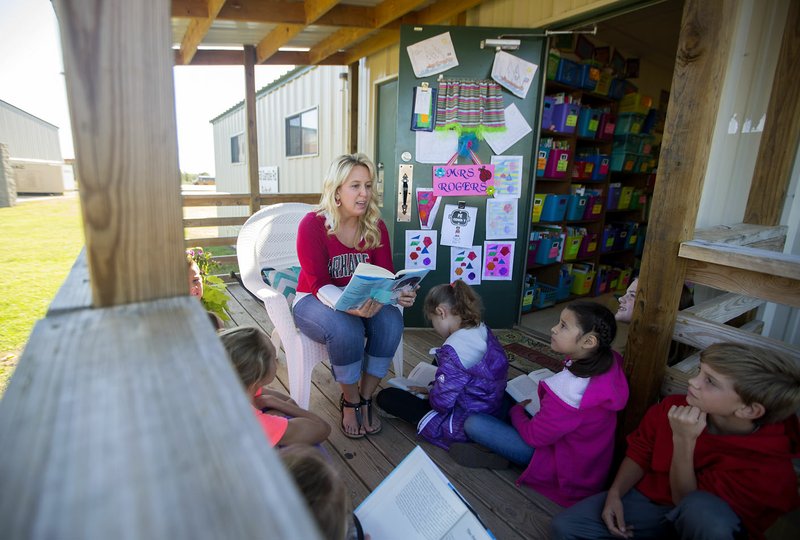Nona Rogers’ fourth-grade classroom at Centerton Gamble Elementary School looks and feels much like any other elementary classroom from the inside, but it’s contained within one of two portable buildings on campus.
Rogers has taught for 20 years. This is her first time teaching in a portable classroom. She volunteered to take one when the school found out last spring portables were coming.
“We call it our cozy cottage. It’s very cozy in here,” she said.
She and her 27 students are making the best of the situation, although life outside the main school building has its challenges, Rogers said.
School districts often resort to portable classrooms to meet space needs, at least temporarily, when enrollment growth outpaces the ability to build new facilities.
Some mock portables as aesthetically unpleasing. Others have raised concerns about their air quality, safety and security.
Randy Barrett, superintendent of the Gentry School District, sees them in a more positive light.
“I would hate to have a whole campus of portable classrooms, but in terms of having to have one or two to meet some unanticipated growth or to help you meet just a short-term space issue, sometimes they’re a salvation,” he said.
Gentry just bought a two-classroom portable building for $96,000. It will be delivered to the high school. The district also had some portable classrooms for a few years before the new Gentry Primary School opened in 2007, Barrett said.
“If you’re sitting inside it, you’re really not going to be able to tell you’re in a portable classroom. These things meet all the required building codes. They’re anchored to the ground. A puff of wind isn’t going to come and blow them away,” he said.
The Bentonville School District installed two portable buildings at Gamble this summer, moving them from Bentonville High School. Gamble’s enrollment was 796 as of Sept. 1, up from 694 students one year earlier.
Both portable buildings contain two classrooms and have bathrooms attached. All four classrooms are occupied by fourth-grade classes, about 100 students in all. The buildings sit on the south side of the parking lot, roughly 300 feet from the school’s main entrance.
The space is a little less than what she’s used to, but Rogers said the closer quarters actually has helped develop greater camaraderie among its occupants.
“I think I’ve bonded with this group. They’ve learned to be a little more tolerant of things,” she said.
The porch outside her classroom door has a homey feel: There’s a chair with pillows, some potted flowers and a garden gnome. There’s also a bird feeder and a set of wind chimes. On pleasant days, Rogers’ students may sit on the porch and read or listen to Rogers read aloud.
“So there are some advantages to being out here,” she said.
Her students mostly stay in the classroom from 7:30 a.m.to 12:30 p.m. each day before flocking to the main building for lunch, recess and an activity class such as physical education or music. Rogers keeps umbrellas on hand in case their walk across campus is rainy.
The planned opening of two new schools in Bentonville next year could eliminate the need for portables in the district, at least for a while. However, considering the district grew by more than 500 students in the past year, nothing is certain.
The district rents each building from Williams Scotsman, a firm that specializes in portables, for about $1,200 per month. Installation typically costs between $7,000 and $12,000, according to Paul Wallace, facilities director for Bentonville. The firm is willing to take care of maintenance issues that arise with the buildings, but most issues can be handled easily by the district’s staff, Wallace said.
Of Northwest Arkansas’ biggest four school districts — Springdale, Bentonville, Rogers and Fayetteville — Bentonville is the only one using portable classrooms this school year.
Having portable buildings on campus makes security plans a little more complicated for schools.
Some of the more common challenges have to do with access in and out of the main building for students using those portable classrooms, said Kenneth Trump, president of National School Safety and Security Services, a Cleveland-based consulting firm.
“How much traffic are you going to have between the modular site and regular school building? What does that mean for access control? How are students going to get in and out?” Trump said.
There’s the issue of communications capabilities between the portables and the main building. Portable buildings should have the same ability to be notified of an emergency as any other classroom, he said.
Portable buildings also are at greater risk for after-hours vandalism and burglaries, so alarm protection has to be considered, he added.
Gamble teachers keep their portable classrooms locked during school hours and have peepholes in their doors, Wallace said.
While the students must walk from their classrooms to the main building for some things during the school day, “at the end of the day, they take those same sidewalks to go to the car lines and bus lines where they’ll be just as exposed to any sort of danger,” he said.
Condition of America’s Public School Facilities, the report produced in 2014 by the National Center for Education Statistics, showed use of portable buildings is higher among schools with high poverty rates, as demonstrated by the percentage of students eligible for free or reduced-price meals.
Twenty-five percent of schools with a poverty rate less than 35 percent had portable buildings, whereas 39 percent of schools with a poverty rate of 75 percent or more had portables.
The report also showed school officials were less satisfied with environmental factors of portable buildings compared to permanent buildings.
For example, 9 percent of respondents rated indoor air quality of the permanent buildings as unsatisfactory or very unsatisfactory. The rate was 16 percent for portable buildings.
Natural lighting and acoustics or noise control also rated worse in portables.
However, satisfaction rates with heating, air conditioning and ventilation for portables were either better than or close to rates reported for permanent buildings.
Barrett said a great deal of thought goes into the installation of portable classrooms.
“I’m going to guess if you could go back into the 1940s and pull some students out of some of those one-room school houses, I think they would be ecstatic to be in some of the modern portable classrooms we have today,” he said.
Dave Perozek can be reached at [email protected] or on Twitter @NWADaveP.
“I’m going to guess if you could go back into the 1940s and pull some students out of some of those one-room school houses, I think they would be ecstatic to be in some of the modern portable classrooms we have today.”
— Randy Barrett, Gentry School District superintendent


